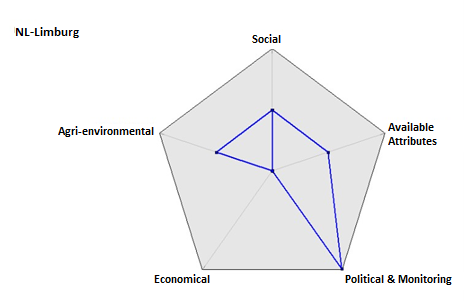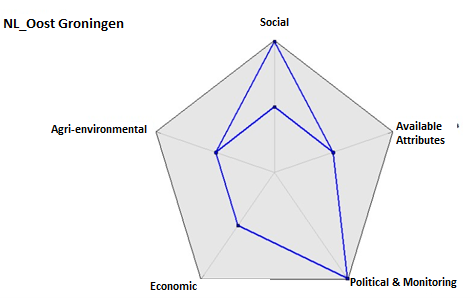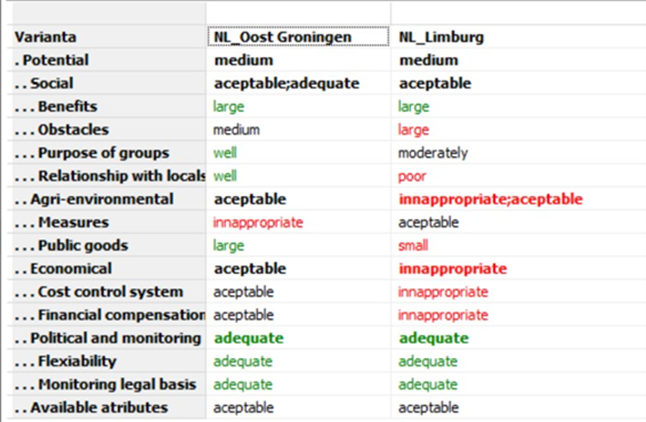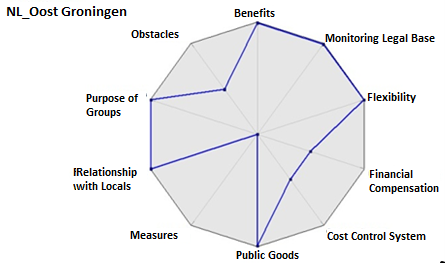The Multi-criteria Decision Making (MCDM) method is an excellent tool to assess different options by evaluating conflicting criteria in order to make an informed decision. In Contracts2.0 we are applying this method on evaluating the performance of two case studies implementing the collective approachrefers to a collection of approaches that involve more than two individuals or parties who are progressing towards a common goal by undertaking collective action. Collective approaches may make use of collective contracts and coll... More. Their results show different levels of fulfilling the (sub-)objectives, contributing to the main objective of providing environmental public goodsPublic goods are non-rival (they cannot be exhausted) and non-excludable (there are no boundaries). An environmental example in the Contracts2.0 context is an open and beautiful landscape which can be enjoyed by one person without... More to a varying extent. Comparing the different results can help to identify the weaknesses of certain options and support the design of effective agri-environmental schemes.
This week, C2.0-partners from University of Ljubljana, working on an ex-post analysis of existing collectives, presented a paper about a multi-criteria decision support system which can inform the design and evaluation of novel contractual models by analysing the potential of existing contracts. This paper was presented at the 16th International Symposium on Operational Research in Slovenia from 22nd to 24th September 2021.
Comparing the Performance of the Collectives
The presented research is exploring the sensitivity of the multi criteria decision making model for comparing the potential of different types of coordinated agri-environmental measures (AEM) or collactives. The Dutch Contracts2.0 collective case studys Limburg and Oost Groningen were chosen as subjects for this study. The results are presented with the help of a web chart (Fig.1 and 2). The test model suggests that the two collectives mainly differ in the attributes “social” and “economic” aspects.


Fig. 1: Web chart for the NL_Limburg – attributes
Fig. 2: Web chart for NL_Oost Groningen – attributes
Collectives show different Performance Levels
Fig. 3 shows a more detailed breakdown of the differences by criteria. If we take a closer look at the economic factor in both cases, we see that the NL_Limburg case has both criteria for the “economic” attribute very poorly assessed. The SWOT analysisSWOT stands for Strengths - Weaknesses - Opportunities - Threats. The SWOT analysis is used in strategic planning and is intended to identify key factors that are important for achieving a specific goal. Strengths and weaknesses a... More (from which the original information about the characteristics of these two cases stems from) showed that there is practically no cost reduction for farmers in NL-Limburg case arising from joining the collective. In contrast, the NL_Oost Groningen collective provides an organized group purchase of seedlings and seeds to ensure a better price and thus receiving a better economic assessment.

Fig. 1: Web chart for the NL_Limburg – attributes
Weaknesses of the Model Need to be Addressed
In this test model, the equal weight for factors and individual decision-making approach was used, which eventually, reflected in the lack of sensitivity of the test model and should be corrected in the final decision model.
The final decision model will compare nine different case studies implementing the collective approachrefers to a collection of approaches that involve more than two individuals or parties who are progressing towards a common goal by undertaking collective action. Collective approaches may make use of collective contracts and coll... More to AEM. It will not use an equal weight for factors, instead the analytical hierarchy process pair wise comparison method for calculation of weights assigned to factors will be made with a combination of Delfi method. Delfi method includes several expert’s view and can reflect a group decision making effort so at the end a consensus for assigning weights to factors will be made.
The final decision model will be applied for selected case study sites in order to identify the contracts with the highest probability to provide the desired provision of environmental public goodsPublic goods are non-rival (they cannot be exhausted) and non-excludable (there are no boundaries). An environmental example in the Contracts2.0 context is an open and beautiful landscape which can be enjoyed by one person without... More (EPG) and ecosystem services along with marketable agricultural private goodsare the objects from ecosystems that people value through experience, use or consumption, whether that value is expressed in economic, social or personal terms. Note that the use of this term here goes well beyond a narrow definit... More. It will show weaknesses and strengths for each individual case study and it will give insight into the factors that can have greatest effect to the provision of EPG. This will then be applicable as a new knowledge for the design of the novel contracts for EPG that the Contracts2.0 project is all about.
For more detailed information have a look at our paper, which we presented at the 16th International Symposium on Operational Research.
Written by: Janja Rudolf & Andrej Udovč, Biotechnical faculty, University of Ljubljana (Slovenia)


